“If you build it, they will come.”
It might have been true in Field of Dreams, but it’s not necessarily true for the food truck of your dreams. No matter how fantastic your food is (and we’ll bet it’s pretty great), you need to put in the leg work if you’re going to attract hungry customers.
Whether you’ve just started your food truck, you have an established business, or you’re still in the planning stage, these food truck marketing tips could give your business a boost.
Create Your Brand Identity
As an individual, you have an identity built around your likes and dislikes, personality traits, and interests.
Your business also needs an identity. But instead of a personality and interests, your business’ identity—or brand—is built from the company offerings, mission, voice, and creative assets. This includes identifiers like a name, logo, and visuals, as well as the menu, brand voice, and how you present your truck to the public.
Many food truck owners choose to do their own branding. Design tools like Canva can make it easy to choose brand colors and create a logo.
But there are also talented branding professionals out there who can help you with this step. Getting the branding right could help your truck to attract more foot traffic and stand out among the other trucks in the park, on the street, or wherever you park your food truck.
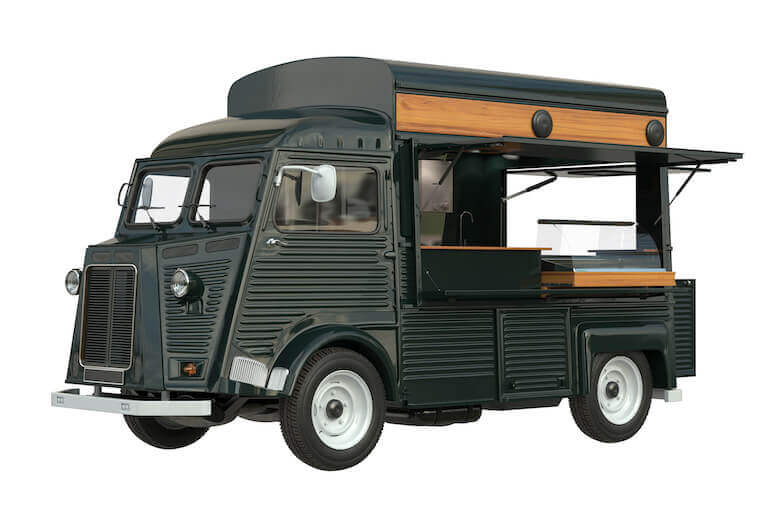
A unique truck like this certainly has a one-of-a-kind visual identity!
How to Name Your Food Truck
From a searchability perspective, you may want your truck’s name to describe the food you’re serving. For example, Escoffier graduate Nahika Hillery originally named her truck Kréyol Korner Caribbean Cuisine. And popular Boulder food truck Holy Crepe!! created a name that is both a cheeky play on words and descriptive of the type of food to expect.
Of course, not all trucks go this direction. Some prefer to be a bit more open-ended, like Escoffier graduate Freida Nicole’s farm-to-table truck, Freida’s Sweets and Meats.
When choosing your name, make sure it’s:
- Short and memorable, so customers won’t forget it
- Intriguing, to build curiosity around your truck
- Available! Google the name and do a name search with your Secretary of State to ensure the name isn’t already taken. Skipping this step could get you into legal trouble down the line.
Visual Identity: Logos, Fonts, and Brand Colors
Once you have your brand’s name, you’ll need to start creating its visual identity. A good place to start is with a logo, fonts, and brand colors.
Your logo and brand colors should help to express your brand identity. A fun hot dog truck may want splashy colors and a cartoony logo, while a farm-to-table truck may want something more polished to express a serious approach to sustainability.
When designing your logo, take scale into account. You may want to display the logo on the side of your truck, so make sure your logo looks good both small and large.
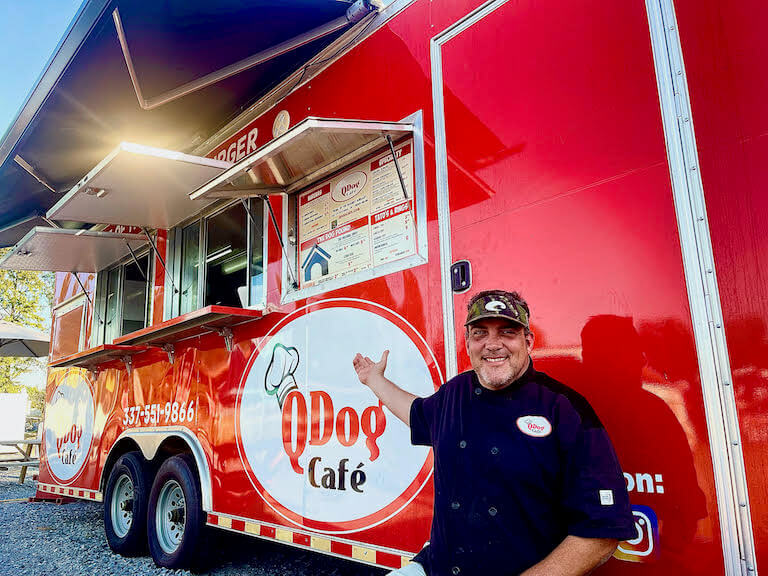
Escoffier graduate Quinten Adcock uses a simple logo for his truck that looks great at any scale.
Designing Your Truck’s Look
Whether you buy your food truck new or used, it’s unlikely to match your brand aesthetic. So you’ll probably need to do some upgrading to make it fit in with your overall look.
Your truck’s design can be as simple or complex as you wish. Some owners choose to paint their trucks a solid color and rely on signs and menu boards to add personality. Some commission custom paint jobs to add their brand colors and logo. And others choose vinyl wraps, which give them the opportunity to create complex designs and details. Wraps are usually the most expensive option.
Whatever you choose, it’s usually a good idea to hire a professional for this!
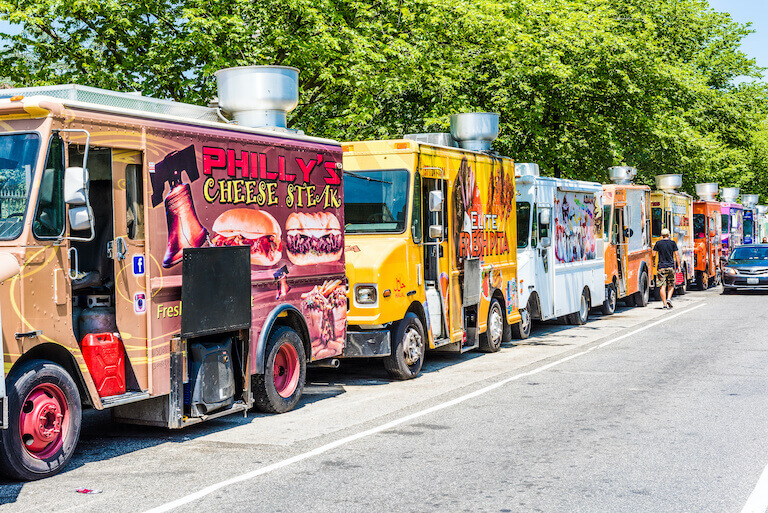
These trucks have vinyl wraps to share complex illustrations.
Reach Your Target Customers Online
A food truck’s online presence is equally as important as its in-person presence. Use these tips to build a strong digital footprint.
Own Your Platform with Your Own Website
In the modern age of social media, do you really need your own website?
YES.
We’ll talk more about social media shortly, but remember this: even if you have a wildly popular account on Instagram, Facebook, Twitter, or Tiktok, you do not own that platform. You can get hacked. Your account could get disabled. The algorithms change frequently. These platforms could even disappear entirely, a la MySpace.
These sites are valuable tools. But you also need some marketing “real estate” that you own. And that’s your website.
Your site can be simple, listing your hours, location, menu, and links to online ordering (if you offer it). But your website will provide a home base to link to from review sites and your social media profiles. Plus, having a website can help make it easier to find you when people are searching for food in the area.
When you (or a web developer) create your website, it should also be mobile-friendly. One study found that 89% of all searches for food and beverages are currently conducted on a cell phone or tablet. Websites that aren’t designed for mobile viewing may display text too small, have layouts that stretch beyond the phone’s parameters, or have PDF menus that must be “pinched in” to read. A website that’s not user-friendly on mobile could lead to lost site visitors before they get the chance to become customers.
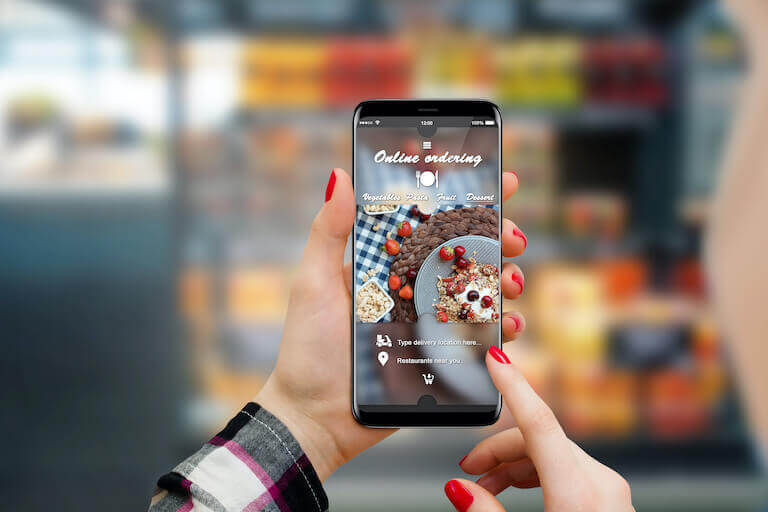
A mobile-friendly website will help people find your food truck when they are searching for a meal on their phones.
Create Listings On Popular Review Sites and Truck Directories
Review sites like Yelp, TripAdvisor, and OpenTable are still very popular with certain users. Create profiles that you can manage on each of these sites to reach a wider audience. Make sure they all link back to your website!
It’s also a good idea to monitor these sites so you can respond to reviews. Saying “thank you” for a positive review or addressing a negative review with grace and tact can build trust with your audience and make them feel like the business cares about their experience.
You can also share your truck’s location on food truck-specific sites like Roaming Hunger, Mobile Nom, and Food Trucks In. These sites share truck locations in real-time, making it easier for foodies to find you.

Responding to online reviews can help customers feel heard.
Set Up a Google My Business Profile
Google My Business (GMB) will be a valuable source of reviews, just like Yelp and TripAdvisor. But its value goes even further.
A complete GMB profile will populate the “Google Knowledge Panel” sidebar when people search for your food truck. It may show your location, hours, and photos that you or your customers have uploaded. It may also have direct links to Google Maps, your website, and to online ordering options. This is prime real estate in digital search results and you’ll want to capture it!
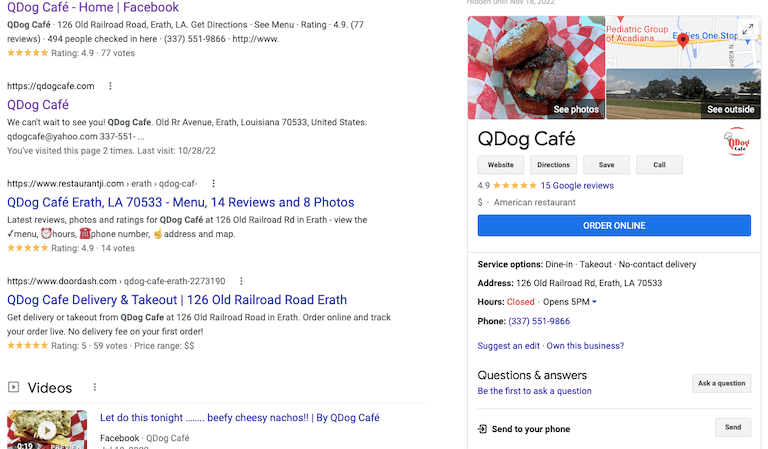
This Google Knowledge Panel for QDog Café (owned by Escoffier graduate Quentin Adkins) is populated with information from GMB and other online sources.
This profile can also help your local searchability, making it more likely that your food truck will show up in the Google Local Pack that appears at the top of Google search results for some location-based searches.
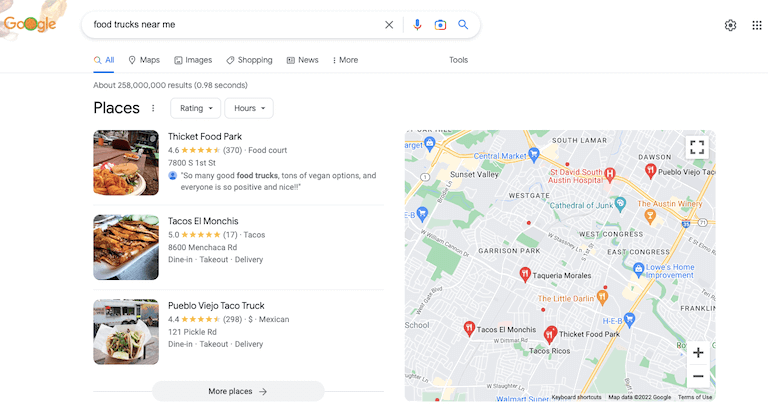
The search “food trucks near me” can give users a listing of nearby options in the Google Local Pack.
Spread the Word on Social Media
Social media is one of the best ways to spread the word about your business. It’s going to be an important part of your food truck marketing plan!
You can use social media to share photos and videos of your food, your staff, your customers, and more. You can share your truck’s location if you move around, or release new menu items to build buzz. Here’s how to get started.
Choosing Your Platforms
You’re a busy food truck owner. So you probably don’t have time to fully optimize all social media platforms. Instead, focus on the one or two that best fit your audience. Whether you anticipate serving primarily college students, a partying crowd, or the professional set, there’s probably one or two social sites that are more likely to reach those customers.
Check out these numbers to start thinking about where your customers are hanging out online, so you can decide how best to connect with them.
Social Media Platform Demographics
| TikTok | ||||
|---|---|---|---|---|
| Monthly Active Users | 211 million | 2.91 billion | 2 billion | 1 billion |
| Largest Age Groups (in the US) | 18-29 (42% of users) 30-49 (27% of users) | 25-34 (34% of users) 18-24 (26% of users) | 25-34 (31.2% of users) 18-24 (31% of users) | 10-19 (25% of users) 20-29 (22.4% of users) |
| Gender Breakdown | 38.4% female 61.6% male | 43% female 57% male | 48.4% female 51.8% male | 61% female 39% male |
Creating Content
Once you know where to post, what will you post? Start simple, with photos of your food and descriptions of each dish. You can post behind-the-scenes videos of your cooks in action, or share updates about where your truck will be that day. You could also do introductions of your staff members.
Aim for consistency. You don’t have to post every day, but try to post on the same days each week to build a rhythm.
Feel free to reuse content across platforms. For example, you could make videos on TikTok and re-upload them to Instagram. Or post photos to Facebook and crosspost them to Twitter. No need to make all new assets for each platform you choose to use!
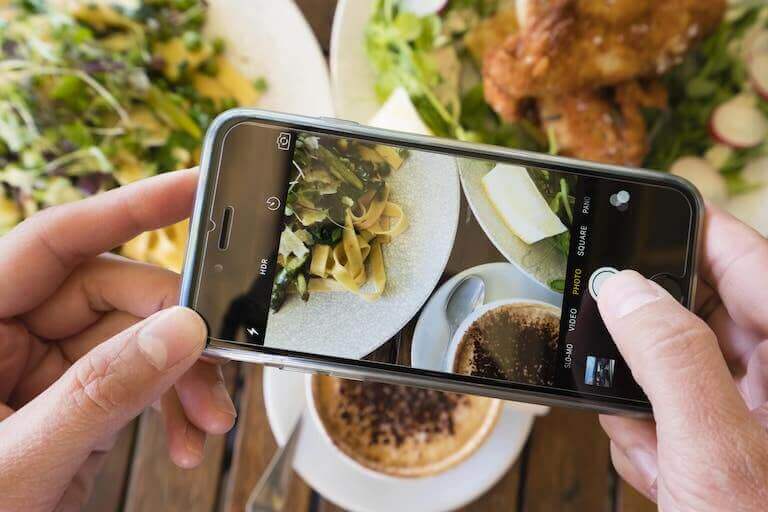
Take Advantage of User-Generated Content
Creating content can be a challenge. It requires you to take quality photos or videos and come up with interesting or clever captions.
You can lighten the load with user-generated content (UGC). This simply means you re-post photos and videos shared by your customers. Always ask for permission before doing this, since the person who originally created the content owns it. You can simply reach out through the customer’s direct messages to get their okay. Customers are usually happy for you to share their posts, as long as you tag them!
Working with Influencers
Don’t be afraid to lean on foodie influencers for help. These social media superstars are experts at spreading the word about establishments they love, and they may be happy to promote your business to their followers.
Local influencers could be “micro-influencers” with 10,000 to 50,000 followers. Or they could have larger audiences of 100,000+ followers. Influencers with a higher follower count may charge a fee to share your food, so it’s often best to reach out to the smaller accounts. They may be happy to share a post in exchange for a free meal, and they could have a dedicated following of loyal fans.
A post by someone with 20,000 followers can be wonderful for spreading the word about your new truck to thousands of new potential customers.
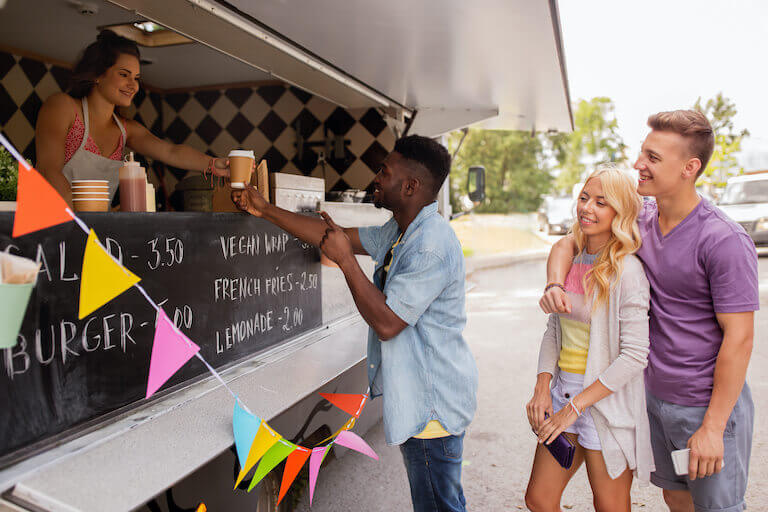
Attract a crowd with a shoutout from a local influencer.
Leverage the Press and Blogs
Press mentions may seem “old hat” in the era of social media. But they are not.
Local food blogs and magazines still get a wide readership, and might end up bringing you tons of business! Do some online research to find the top food publications in your area. Eater and edible have outlets in many major cities, and there are independent local outlets like Chicago Food Magazine in Chicago and Tribeza in Austin.
All of these outlets need content. Share news about your truck through a simple press release, and see if it gets picked up. You could update them on a new location, a revamped menu, a collaboration with another chef, or any other news of note.
If you have a unique story, you may even be able to get a feature! Escoffier graduate and food truck owner Nahika Hilary got a wonderful writeup in Austin’s Tribeza.
Carve Out Dedicated Time for Marketing
Continuous marketing is critical to the ongoing success of your food truck. But if you don’t proactively build time for these tasks into your schedule, they will always be pushed off for something more urgent. So set aside a few hours each week to plan the next week’s posts, reach out to influencers, and update your website, if necessary.
Consistent focus on these tasks is where the results come from!
To learn more about marketing your food business, consider a degree or diploma in Food Entrepreneurship from Escoffier. With detailed coursework in general marketing principles as well as subjects unique to hospitality, this education could help you to better understand and reach your ideal customers!
Contact us for more information about our programs today.
Want more tips for running your own food business? Give the following articles a try:
- How Much Does a Food Truck Cost?
- The 5 Best Food Truck POS Systems
- How Much Money Do Food Trucks Make?
This article was originally published on April 26, 2021, and has since been updated.

